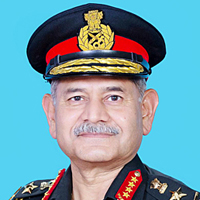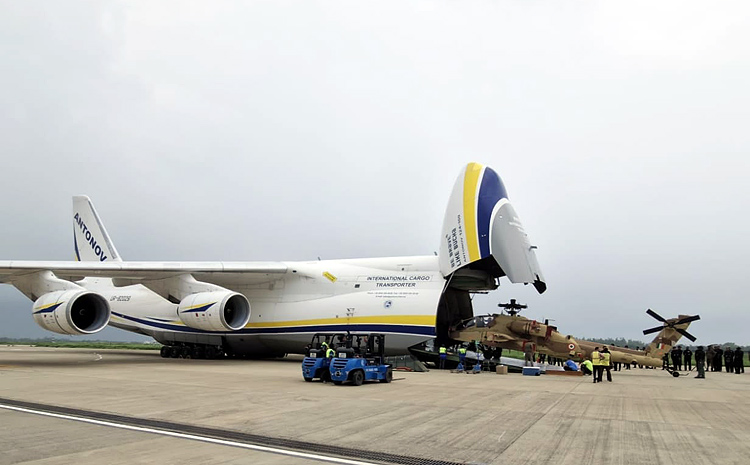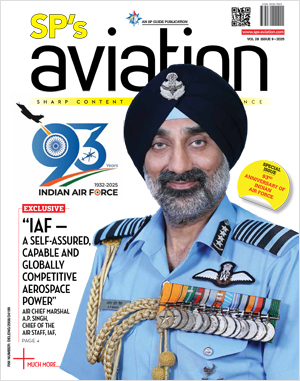INDIAN ARMED FORCES CHIEFS ON OUR RELENTLESS AND FOCUSED PUBLISHING EFFORTS

The insightful articles, inspiring narrations and analytical perspectives presented by the Editorial Team, establish an alluring connect with the reader. My compliments and best wishes to SP Guide Publications.

"Over the past 60 years, the growth of SP Guide Publications has mirrored the rising stature of Indian Navy. Its well-researched and informative magazines on Defence and Aerospace sector have served to shape an educated opinion of our military personnel, policy makers and the public alike. I wish SP's Publication team continued success, fair winds and following seas in all future endeavour!"

Since, its inception in 1964, SP Guide Publications has consistently demonstrated commitment to high-quality journalism in the aerospace and defence sectors, earning a well-deserved reputation as Asia's largest media house in this domain. I wish SP Guide Publications continued success in its pursuit of excellence.
- A leap in Indian aviation: Prime Minister Modi inaugurates Safran's Global MRO Hub in Hyderabad, Calls It a Milestone
- All about HAMMER Smart Precision Guided Weapon in India — “BEL-Safran Collaboration”
- India, Germany deepen defence ties as High Defence Committee charts ambitious plan
- True strategic autonomy will come only when our code is as indigenous as our hardware: Rajnath Singh
- EXCLUSIVE: Manish Kumar Jha speaks with Air Marshal Ashutosh Dixit, Chief of Integrated Defence Staff (CISC) at Headquarters, Integrated Defence Staff (IDS)
- Experts Speak: G20 Summit: A Sign of Global Fracture
Indian Army inducts advanced Apache attack helicopters from the US, boosts critical Army Aviation Corps
The Indian Army has officially inducted the Boeing AH-64E Apache attack helicopters, a formidable platform which will boost the operational capability Army Aviation Corps (AAC). The Apache, an advanced, multi-role combat helicopter developed by Boeing, is widely known for open-desert engagements to high-altitude warfare and urban combat environments.

The Indian Army has officially inducted the Boeing AH-64E Apache attack helicopters, a formidable platform often referred to as a "tank in the air." The state-of-the-art helicopters were procured from the United States under a $600 million deal in 2020 to acquire six Apache for the Army. While it marked a significant delay over delivery, which was expected by June 2024, the induction of three helicopters puts an end to the waiting period and operational gaps.
The acquisition of Apache marks a crucial modernisation step for India's rotary-wing strike force, particularly for operations in high-altitude and border regions.
Indian Army has already set up a squadron under the Army Aviation Corps (AAC) with a total fleet of 350 helicopters that includes indigenous attack helicopters and also Soviet-origin Mi-25/Mi-35. The squadron is set up in Jodhpur, Rajasthan, which is slated to be operational upon the acquisition.
The acquisition of Apache marks a crucial modernisation step for India's rotary-wing strike force, particularly for operations in high-altitude and border regions. The AAC in its mechanised role is crucial for attack and counter-insurgency operations, apart from logistics and deployment.
The remaining three helicopters are expected to be delivered later this year.
Technical overview: AH-64E Apache
The AH-64E Apache Guardian is an advanced, multi-role combat helicopter developed by Boeing. It is the most modern variant of the Apache series and is designed to dominate across a range of conflict scenarios – from open-desert engagements to high-altitude warfare and urban combat environments.
The remaining three helicopters are expected to be delivered later this year.
Armament capabilities
- M230 Chain Gun: A 30mm hydraulically driven, single-barrel cannon mounted beneath the aircraft's fuselage, capable of firing up to 625 rounds per minute. It provides accurate, high-rate fire for close air support and anti-infantry missions.
- AGM-114 Hellfire Missiles: The Apache can carry up to 16 laser-guided Hellfire missiles, specifically designed for tank and armoured vehicle destruction. These fire-and-forget munitions can engage multiple targets with surgical precision.
- Hydra 70 Rocket Pods: The helicopter is equipped with pods containing 70mm unguided rockets that are effective for area suppression, soft target engagement, and indirect fire support.
- AN/APG-78 Longbow Fire Control Radar: A radar system mounted above its rotor is a key feature giving Apache its over-the-horizon targeting ability. It enables the detection, classification, and prioritisation of up to 128 targets simultaneously, with 16 being engaged in quick succession.

Avionics and navigation systems
The AH-64E Apache is integrated with a range of next-generation avionics systems, which include the Target Acquisition and Designation Sight/Pilot Night Vision Sensor (TADS/PNVS). This system provides day, night, and adverse weather visibility for both targeting and piloting. It allows for real-time, stabilised image tracking and laser designation for weapons guidance.
Additionally, Apache is also integrated with Modernised Targeting Systems (M-DSA) to enhance electro-optical sensors to give superior image quality and target discrimination, significantly boosting the accuracy of weapon delivery.
The ability to provide close air support (CAS), destroy enemy armour, and conduct precision strikes during day, night, and under adverse weather makes the Apache a formidable platform for Indian ground forces.
Alongside, the platform is well embedded with global positioning and inertial navigation systems (GPS/INS) for precision navigation, especially in GPS-denied or degraded environments.
However, the most upgraded is the secure communications suite, which has multi-band radios, data links, and secure communication systems enabling seamless integration with ground forces and other aerial platforms in network-centric warfare environments.
The Apache is known for its survivability, which is about its composite rotor blades. Its high-durability blades provide increased lift and survivability against small-arms fire.
Boeing has also integrated infrared suppression and countermeasure systems in AH-64E. It works in combination of missile warning receivers, radar warning receivers, and infrared jammers to evade or disrupt enemy air defence systems.
These "flying tanks" are poised to play a critical role in future combat operations and joint-force manoeuvres.
Operational role in Indian Army
Unlike the Indian Air Force, which already operates Apache helicopters, these new units are tailored specifically for the Army's frontline support roles. The deployment will primarily focus on supporting armoured and mechanised operations in border regions like Ladakh, Arunachal Pradesh, and the Western Desert Sector.
The ability to provide close air support (CAS), destroy enemy armour, and conduct precision strikes during day, night, and under adverse weather makes the Apache a formidable platform for Indian ground forces. Its deployment alongside T-90 and Arjun tanks significantly enhances the Army's offensive and defensive posture.
The induction of AH-64E Apaches adds greater firepower to the Indian Army by combining advanced situational awareness and survivability. These "flying tanks" are poised to play a critical role in future combat operations and joint-force manoeuvres. As regional security dynamics evolve, this new capability adds a decisive edge to India's military readiness and deterrence architecture.
Manish Kumar Jha is a Consulting & Contributing Editor for SP's Aviation, SP's Land Forces and SP's Naval Forces and a security expert. He writes on national security, military technology, strategic affairs & policies.





